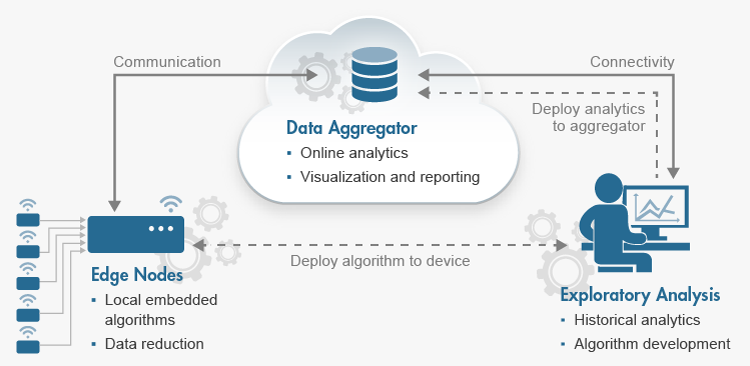3 Big Technologies that will Shape the FUTURE of your Business
Internet of Things (IoT) describes an emerging trend where a large number of embedded devices (things) are connected to the Internet. These connected devices communicate with people and other things and often provide sensor data to cloud storage and cloud computing resources where the data is processed and analyzed to gain important insights. Cheap cloud computing power and increased device connectivity is enabling this trend.

At a high level, many IoT systems can be described using the diagram above. The left side of the diagram illustrates edge nodes. Edge nodes are devices that collect data and include devices such as wireless temperatures sensors, heart rate monitors, and hydraulic pressure sensors. The middle of the diagram shows the data aggregator. The aggregator collects, processes and stores data from many edge nodes that are often geographically dispersed, and it may have the capability to analyze and take action on the incoming data.
Cyber Security
Network outages, data compromised by hackers, computer viruses and other incidents affect our lives in ways that range from inconvenient to life-threatening. As the number of mobile users, digital applications and data networks increase, so do the opportunities for exploitation.

WHAT IS CYBER SECURITY?
Cyber security, also referred to as information technology security, focuses on protecting computers, networks, programs and data from unintended or unauthorized access, change or destruction.
WHY IS CYBER SECURITY IMPORTANT
Governments, military, corporations, financial institutions, hospitals and other businesses collect, process and store a great deal of confidential information on computers and transmit that data across networks to other computers. With the growing volume and sophistication of cyber attacks, ongoing attention is required to protect sensitive business and personal information, as well as safeguard national security.
During a Senate hearing in March 2013, the nation's top intelligence officials warned that cyber attacks and digital spying are the top threat to national security, eclipsing terrorism.
Machine Learning
Evolution of machine learning
Because of new computing technologies, machine learning today is not like machine learning of the past. It was born from pattern recognition and the theory that computers can learn without being programmed to perform specific tasks; researchers interested in artificial intelligence wanted to see if computers could learn from data. The iterative aspect of machine learning is important because as models are exposed to new data, they are able to independently adapt. They learn from previous computations to produce reliable, repeatable decisions and results. It’s a science that’s not new – but one that’s gaining fresh momentum.
While many machine learning algorithms have been around for a long time, the ability to automatically apply complex mathematical calculations to big data – over and over, faster and faster – is a recent development. Here are a few widely publicized examples of machine learning applications you may be familiar with:
- The heavily hyped, self-driving Google car? The essence of machine learning.
- Online recommendation offers such as those from Amazon and Netflix? Machine learning applications for everyday life.
- Knowing what customers are saying about you on Twitter? Machine learning combined with linguistic rule creation.
- Fraud detection? One of the more obvious, important uses in our world today.

Why is machine learning important?
Resurging interest in machine learning is due to the same factors that have made data mining and Bayesian analysis more popular than ever. Things like growing volumes and varieties of available data, computational processing that is cheaper and more powerful, and affordable data storage.
All of these things mean it's possible to quickly and automatically produce models that can analyze bigger, more complex data and deliver faster, more accurate results – even on a very large scale. And by building precise models, an organization has a better chance of identifying profitable opportunities – or avoiding unknown risks.
What's required to create good machine learning systems?
- Data preparation capabilities.
- Algorithms – basic and advanced.
- Automation and iterative processes.
- Scalability.
- Ensemble modeling.

Did you know?
- In machine learning, a target is called a label.
- In statistics, a target is called a dependent variable.
- A variable in statistics is called a feature in machine learning.
- A transformation in statistics is called feature creation in machine learning.

0 Comments